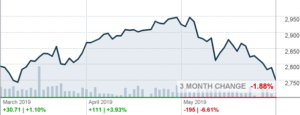It wasn’t long ago that volatility seemed to have flat-lined. Those were the good old days.
Just look at market results for the past two months and you’ll see a pretty stark contrast. In April, the S&P 500 and the Nasdaq Composite index reached record highs. In May, the market recorded weekly losses.
Risky investments are suffering the most, as the risk switch has flipped to off.
“What concerns me is the near vertical strength of historically leading indicators of volatility,” said Michael A. Gayed, CFA of Pension Partners, LLC.
While hoping that the record bull market doesn’t come to a sudden dramatic end, Gayed outlines a comprehensive list of reasons why it may:
Utilities. The stock market’s most interest-rate sensitive sector, utilities tend to perform well just before the stock market doesn’t. Recently, they’ve provided strong returns, performing as they did just before the market collapsed in December 2018.
Treasuries. The yield curve is just 0.16% away from inverting for two-year and 10-year Treasuries. It has already inverted for some other maturities. “When long duration is outperforming intermediate, historically equities have also experienced higher volatility afterwards with a lag,” Gayed noted.
Lumber. Exchange traded funds focusing on home construction have been hot this year, but lumber has fallen to its lowest level since 2016. Overall, the housing market is weakening, even as new home sales have improved.
Technology. Tech stocks have been lagging, due to a decline in the chip sector, which is among the sectors most affected by a chilling relationship with China. The U.S. ban on business with China’s Huawei could also have a significant impact on the sector moving forward, as China retaliation could further erode exports.
Small caps. While the economy is still performing well as a whole, investors are in risk-off mode and declining earnings in this group have convinced them that higher prices are unwarranted. Earnings of large-cap companies grew 2% to 3% in Q1, but earnings of small-cap companies declined 10%.
Bonds. As the trade war with China began escalating, investors moved into Treasuries. Today, though, fixed-income investments are benefiting from a broader rally including government and investment-grade corporate bonds. This suggests that the rally will be sustainable.
“The fact that things flipped in the favor of ultra-short maturities in the midst of a weeks-long Treasury rally even for just a week suggests that investors could be getting more risk-averse,” Gayed wrote.
Gayed noted weakness in other sectors, too, including consumer discretionary, communication services, industrials, materials, energy, junk debt, emerging markets and foreign markets in general.
Taken as a whole, these sectors forecast a potentially gloomy near future, but Gayed concludes that “ … if stocks don’t break down soon, then the opposite may occur. The bulls have a major catalyst, which is simply the oversold positions of cyclical trades and most notably emerging markets and commodities. Given how depressed those have been, bears need to be wary of a ‘tradeable bounce’ in reflation trades that cool volatility.”

